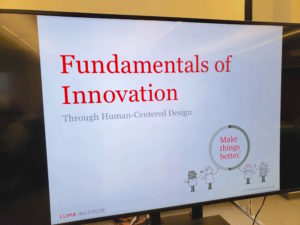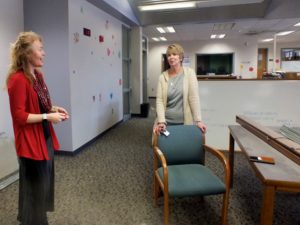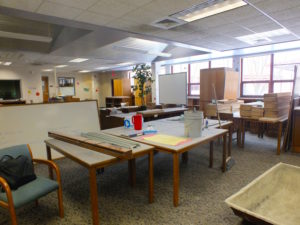Two Brownsville Area educators engaged students to reimagine their District’s middle school library using Human-Centered Design
The shelves are gone. The space has been cleared. The books have been put in storage. It would be at least a couple of weeks before the ceiling tiles came down and the flooring was pulled up.
That’s how things looked at the end of March after French teacher Lynn Jellots and Librarian Jennie Karwatske led a team of students through a process to transform Brownsville Area School District’s underused middle school library into a “Future Readiness Center.”
The process they used was Human-Centered Design, a set of techniques and principles for problem-solving that emphasizes inclusivity and puts stakeholder needs at the center of decision-making. 
Jellots, Karwatske and the district’s Director of Secondary Education, Bill King, learned the techniques during a training session the Consortium offered last fall in partnership with LUMA Institute, a Pittsburgh consulting firm that’s nationally known for offering HCD training to corporate clients. The Grable Foundation supported the training to give educators access to the same tools that have helped companies improve customer focus and efficiency, among other metrics.
The Future Readiness Center may be the end goal of Brownsville’s project, but along with the aim of transforming a library, Superintendent Keith Hartbauer had some less obvious reasons for wanting to test-drive HCD as well.
One was to try a new way of engaging students. Another was to help Brownsville’s students meet new standards for career exploration and preparation that the Pennsylvania Department of Education began assessing this year. All the stars lined up when the Consortium organized its first training session.
“We knew we needed to do some things around career learning, particularly for the middle school,” Hartbauer said. “We were in the right place at the right time for it to happen. We felt if we could create a career center, we’d get to where we needed to be.”

To do the project, Hartbauer fielded a team for the HCD training because he “wanted to create a different mindset, not just for instruction, but for working with kids.”
“I think the whole concept of LUMA training—how it gets students or a group of people to really collaborate, think outside the box and come up with different ways to solve a problem—is very intriguing,” he added.
The district’s Director of Secondary Education came away from the training with much the same feeling. “It’s friendly and it’s positive,” King said at the time. “It’s a unique approach to problem-solving.”
HCD also lent itself well to another of Hartbauer’s goals. “From the very beginning, we wanted students to take ownership of this project,” he said.
The district set some parameters, but within them, Jellots and Karwatske engaged a team to imagine and design a center that would meet the needs students have as they plan for post-secondary education and careers.
Most of the kids working on the project were participants in the high school team that Jellots organizes for The Future Is Mine, the Consortium’s career exploration program. But they also pulled in others as needed, including from the Fayette County Career & Technical Institute, the CTC Brownsville students attend if they want to pursue occupational training in fields like health sciences, graphic design and others.
The team began with an HCD method known as “Contextual Inquiry,” taking field trips to explore schools that already have centers for college and career resources. Together, the site visits and the interviewing and notetaking students did during them were part of the process of “Looking,” one of three broad categories of methods that HCD prescribes, along with “Understanding” and “Making.”
Following the visits, the team worked on “Stakeholder Mapping,” an HCD method included in “Understanding” that helped identify “who would be invested” in the new center, Jellots said. They found the group would include stakeholders ranging from students and teachers to counselors, school board members and even members of the community.

“Abstraction laddering,” an HCD method that’s also in the toolkit for “Understanding”, helped students contribute ideas about the many possible ways the center could be used and how different spaces within the center would need to be equipped. They continued refining their work with additional HCD methods, including “Rose, Thorn, Bud,” which helps distinguish among ideas that are positive, negative or have potential.
The HCD methods they chose—known collectively as their “recipe”— helped students determine features they want the center to offer. Among them will be a wall with white boards and cork boards to post information like college application deadlines; shelving for college catalogues, SAT study guides and other reference materials; computers and possibly a small audio/video laboratory for recording and critiquing mock job interviews, among other things.
Plans also call for the center to open onto an outdoor courtyard and include a small café or coffee shop, where students can get soft drinks or snacks.
Jellots said the students “loved the HCD process” and that everyone is excited to see the center taking shape. Their vision is for the finished space “to have a kind of open, hip, urban feel,” she added.
Jada, a senior on the team, said she liked HCD because the process keeps the most outgoing participants from disproportionately influencing the outcome.
Many HCD methods call for participants to offer ideas on Post-It notes, rather than verbally, she noted. As a result, “everyone gets to be part of it,” Jada said, and their finished work reflects “bits and pieces of everyone’s thinking.”
Kyle, another senior who used a 3-D computer modeling and design program to create schematics for the team, said the way information is gathered and presented using HCD “makes it easy to follow.”
“All the ideas were laid out in front of me,” he said, “so it wasn’t hard to do.”
Similarly, Talia, a sophomore, said the process “really helped us to organize what we were presenting to the school board and give the main ideas.”
The students presented the final drawings to the district’s board late last year. At a subsequent meeting, they won approval for the concept, with different aspects left pending for cost estimates and further analysis of feasibility.
Team members said they were enthusiastic about designing the center because they believe it will help peers and younger students plan for their next steps after graduation and be better prepared.
“I think it will help kids getting ready for college and there will be a place for mock interviews to get kids ready for jobs,” Jada said.
Additionally, she said the center will enable counselors and teachers to better target career presentations at interested students. “We want there to be a space for smaller groups so kids can sign up for presentations,” she added. “Right now, everybody goes to the auditorium when we have a guest speaker and not everybody is interested in the same things.”
Similarly, Karwatske said guidance counselors will be able to invite speakers who can talk about careers that small groups of students identify in “interest-inventories” taken in district schools.
Hartbauer’s view of the proposed center is even more expansive. “We can bring the community in,” he said. “When colleges come, it will be a place where they can present. Businesses can come in and tell kids the skills they need when they’re hiring.”
“What I also like is that the little coffee shop can bring in our special needs kids,” the Superintendent added. He envisions them staffing it and building skills needed in food service, retail and other jobs. From his viewpoint, “We’ll be encompassing a whole range of needs with one center.”
If you or your district would like to participate in one of the Consortium’s upcoming Human Centered Design trainings, please contact Mary Kay Babyak (mbabyak@tcfpe.org) or Jackie Foor (jfoor@tcfpe.org) at 412-678-9215.






